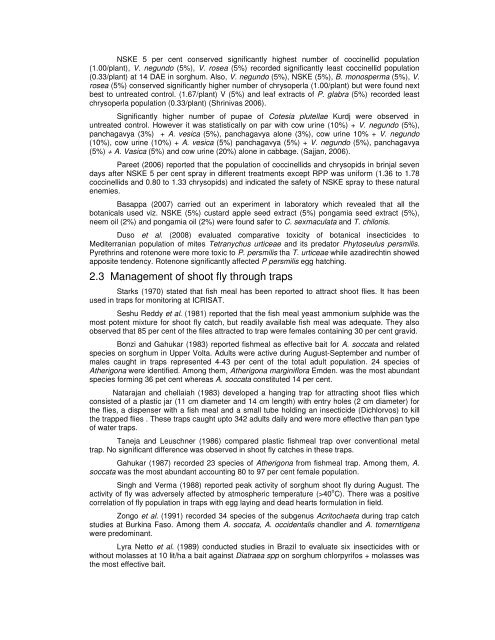NON-CHEMICAL APPROACHES FOR THE MANAGEMENT OF ...
NON-CHEMICAL APPROACHES FOR THE MANAGEMENT OF ...
NON-CHEMICAL APPROACHES FOR THE MANAGEMENT OF ...
Create successful ePaper yourself
Turn your PDF publications into a flip-book with our unique Google optimized e-Paper software.
NSKE 5 per cent conserved significantly highest number of coccinellid population<br />
(1.00/plant), V. negundo (5%), V. rosea (5%) recorded significantly least coccinellid population<br />
(0.33/plant) at 14 DAE in sorghum. Also, V. negundo (5%), NSKE (5%), B. monosperma (5%), V.<br />
rosea (5%) conserved significantly higher number of chrysoperla (1.00/plant) but were found next<br />
best to untreated control. (1.67/plant) V (5%) and leaf extracts of P. glabra (5%) recorded least<br />
chrysoperla population (0.33/plant) (Shrinivas 2006).<br />
Significantly higher number of pupae of Cotesia plutellae Kurdj were observed in<br />
untreated control. However it was statistically on par with cow urine (10%) + V. negundo (5%),<br />
panchagavya (3%) + A. vesica (5%), panchagavya alone (3%), cow urine 10% + V. negundo<br />
(10%), cow urine (10%) + A. vesica (5%) panchagavya (5%) + V. negundo (5%), panchagavya<br />
(5%) + A. Vasica (5%) and cow urine (20%) alone in cabbage. (Sajjan, 2006).<br />
Pareet (2006) reported that the population of coccinellids and chrysopids in brinjal seven<br />
days after NSKE 5 per cent spray in different treatments except RPP was uniform (1.36 to 1.78<br />
coccinellids and 0.80 to 1.33 chrysopids) and indicated the safety of NSKE spray to these natural<br />
enemies.<br />
Basappa (2007) carried out an experiment in laboratory which revealed that all the<br />
botanicals used viz. NSKE (5%) custard apple seed extract (5%) pongamia seed extract (5%),<br />
neem oil (2%) and pongamia oil (2%) were found safer to C. sexmaculata and T. chilonis.<br />
Duso et al. (2008) evaluated comparative toxicity of botanical insecticides to<br />
Mediterranian population of mites Tetranychus urticeae and its predator Phytoseulus persmilis.<br />
Pyrethrins and rotenone were more toxic to P. persmilis tha T. urticeae while azadirechtin showed<br />
apposite tendency. Rotenone significantly affected P persmilis egg hatching.<br />
2.3 Management of shoot fly through traps<br />
Starks (1970) stated that fish meal has been reported to attract shoot flies. It has been<br />
used in traps for monitoring at ICRISAT.<br />
Seshu Reddy et al. (1981) reported that the fish meal yeast ammonium sulphide was the<br />
most potent mixture for shoot fly catch, but readily available fish meal was adequate. They also<br />
observed that 85 per cent of the files attracted to trap were females containing 30 per cent gravid.<br />
Bonzi and Gahukar (1983) reported fishmeal as effective bait for A. soccata and related<br />
species on sorghum in Upper Volta. Adults were active during August-September and number of<br />
males caught in traps represented 4-43 per cent of the total adult population. 24 species of<br />
Atherigona were identified. Among them, Atherigona marginiflora Emden. was the most abundant<br />
species forming 36 pet cent whereas A. soccata constituted 14 per cent.<br />
Natarajan and chellaiah (1983) developed a hanging trap for attracting shoot flies which<br />
consisted of a plastic jar (11 cm diameter and 14 cm length) with entry holes (2 cm diameter) for<br />
the flies, a dispenser with a fish meal and a small tube holding an insecticide (Dichlorvos) to kill<br />
the trapped flies . These traps caught upto 342 adults daily and were more effective than pan type<br />
of water traps.<br />
Taneja and Leuschner (1986) compared plastic fishmeal trap over conventional metal<br />
trap. No significant difference was observed in shoot fly catches in these traps.<br />
Gahukar (1987) recorded 23 species of Atherigona from fishmeal trap. Among them, A.<br />
soccata was the most abundant accounting 80 to 97 per cent female population.<br />
Singh and Verma (1988) reported peak activity of sorghum shoot fly during August. The<br />
activity of fly was adversely affected by atmospheric temperature (>40 o C). There was a positive<br />
correlation of fly population in traps with egg laying and dead hearts formulation in field.<br />
Zongo et al. (1991) recorded 34 species of the subgenus Acritochaeta during trap catch<br />
studies at Burkina Faso. Among them A. soccata, A. occidentalis chandler and A. tomerntigena<br />
were predominant.<br />
Lyra Netto et al. (1989) conducted studies in Brazil to evaluate six insecticides with or<br />
without molasses at 10 lit/ha a bait against Diatraea spp on sorghum chlorpyrifos + molasses was<br />
the most effective bait.
















